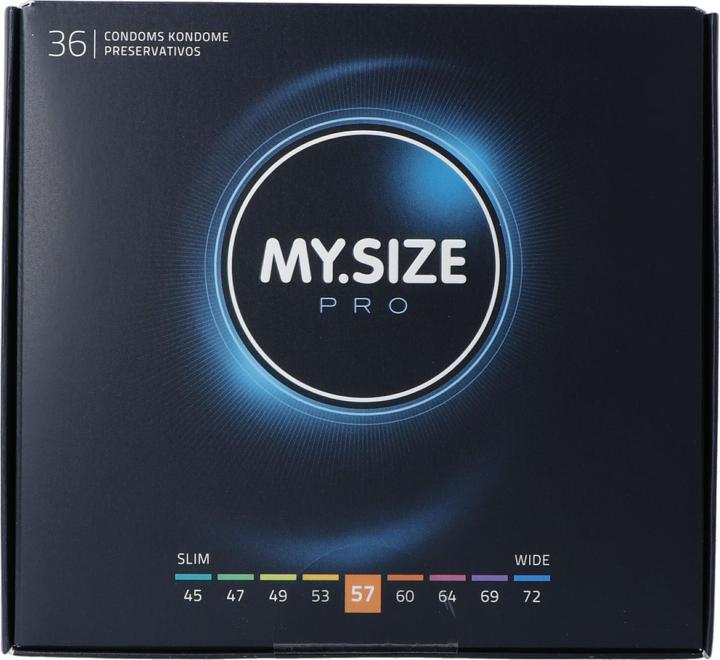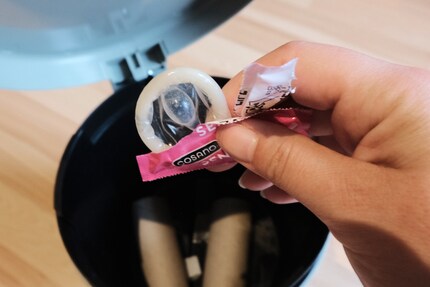

Size does matter when it comes to condoms
We buy trousers, shoes and T-shirts that fit us comfortably. But condoms are often only available in standard sizes. This makes them a bad fit for many and impacts the quality of sex. Perfect-fit condoms are a real alternative, but hard to get your hands on.
«It just doesn’t feel the same,» or, «I don’t like using rubbers.» I’ve heard these kinds of statements on multiple occasions and so have many of my friends. Condoms are passion killers, accused of spoiling the moment, playing havoc with passion and reducing sensation. Secretly, I didn’t take this «whinging» seriously for a long time, but thought the guys were just being difficult or wanting an excuse to proceed without a rubber.
However, I wasn’t perfectly happy with using condoms either. Intercourse would often feel cerebral and unrelaxed after it was put on. The man’s discomfort transferred to me. I heard about similar experiences from my girlfriends. That’s why many of them resorted to hormonal contraception. It just seemed easier – at least temporarily. Coming off the pill during times when I was single cemented the suspicion I’d had for a while: living without the pill makes you feel better both physically and mentally. But what form of birth control does that leave?
Several attempts with the Nuvaring, coil and temperature methods left my circle of friends disillusioned. None of the solutions were satisfactory. The Nuvaring causes vaginal dryness, and the coil is particularly painful during periods. And the temperature method classifies so many days as risky if your routine is irregular that condoms need be used more often than not anyway. So why not just use a condom in the first place?
There’s more out there than strawberry flavour
Online research and conversations lead me to condom brands that offer a full spectrum of shapes and sizes. The girth of the erect penis is critical in choosing the width of the condom. The length is not important. Some of my friends and their partners who discovered this a while back rave about better sex. They no longer find condoms a nuisance. Like a pair of trousers that sits snugly – no pinching or slipping. Extensive ranges of condom sizes are available online, in sex shops and in specialised stores such as Condomeria in Zurich’s old town.
Supermarkets and drugstores only offer standard sizes. Durex, Ceylor and other big names prefer to push strawberry flavoured and ribbed models. Size tends to be neglected. At most, you can choose between small, regular and XL.
According to the market research institute Nielsen, 60 to 70 per cent of the population buy condoms at supermarkets or drugstores. In other words, in places where the big names dominate with their standard sizes.. So it’s unsurprising that many people, just like myself, have no idea how important the right width is.

Think big
On the online market, however, different sized condoms are proving increasingly popular in most countries. At least that’s what Jan Vinzenz Krause says. In 2008, Krause launched the first perfect-fit condoms in Europe with his brand My.Size. Meanwhile, he’s also launched Mister Size. The brand offers seven condom sizes from 47 to 69 millimetres in width. It’s a range that should have 98 per cent of penises covered. Mister Size is available from Galaxus. The reviews suggest that users are just as happy with its products as my friends: «Carefree intercourse at last,» and, «The best condoms I’ve ever tried,» are just two of many positive comments.



LELO HEX Condoms Original
12 pcs.
Krause confirms that the wrong size definitely affects comfort and feeling. «Condoms that are too small put pressure on the penis, which can lead to numbness or erectile dysfunction. If they’re too large, they might slip off and compromise protection.» To find out which size is right for you, Mister Size offers a measuring tape to print out or a sizer for order.
Is the DIN standard to blame?
One question is still unanswered. What’s stopping manufacturers from producing different condom sizes, seeing that customer feedback is so positive? Taking a closer look at the packages of large manufacturers, you’ll see that the sizes are all very similar. For example, while large condoms by the leading brand are 56 millimetres wide, the XXL models are 57 millimetres. This doesn’t seem like a huge difference to me. At least the sizes are now visible on the packages. In fact, they have to be since the EN ISO 4047 standard was introduced in 2002.
Before that, Europe’s standard between 1996 and 2002 was a different one. At the time, the DIN EN 600 standard regulated the testing methods but also the width of condoms. It had to measure between 4.4 and 5.6 centimetres (+/- 2 millimetres). According to Beuth, a publishing company that distributes national and international standards, condoms in Europe at that time usually had a nominal width of 52 millimetres. A My.Size study with 2,500 European men conducted in 2004 came to the conclusion that this standard size is not ideal for 82 per cent of men.
But condoms are stretchable
With the introduction of EN ISO 4074, the width restriction was removed, thereby allowing more leeway when it comes to size standards. This would explain why perfect-fit condoms were difficult to come by until 2002. But since then, condoms in all widths can be manufactured. Yet most big brands aren’t making use of this. 52 millimetres is still being treated as the standard.
There seems to be some scepticism about the need for fitted condoms. «When I programmed my first online condom size guide in 2001, I presented three major manufacturers in Germany with the results. None of them showed any interest. They said that condoms were stretchable, which made various sizes unnecessary. That was 20 years ago. Unfortunately, not much has changed since. This is probably down to the fact that penis sizes and sexuality in general still tend to be taboo. That’s why people’s attitudes are also only changing slowly,» says Krause.
Why can’t at least the existing perfect-fit condoms be found in brick-and-mortar stores? «Drugstore shelves are fiercely competitive. And yet some time ago, My.Size was available at BIPA in Austria and Budnikowsky in Hamburg for about 1.5 years. Until a major condom manufacturer paid a few million and basically bought the shelves from us,» says Krause. However, he also said that he was in the process of getting back into stationary retail. The idea of custom-fit condoms is backed by sexual counselling centres including ProFamilia, which have long been offering size metres themselves and pointing out places to get fitting condoms. The Swiss AIDS federation «Schweizer AIDS-Hilfe» also educates people about the importance of using the right condom size, for example, on their page drgay.ch.
Even a customer service representative at Ceylor, a large Swiss condom manufacturer, said how important the right fit of a condom was. However, in the same e-mail, the representative referred to the company’s FAQs. The question, «How do I find a condom size that is right for me?» was answered with: «The Ceylor range has various models in standard sizes. Thanks to their highly elastic latex material, most users should be comfortable with them.»

Elasticity still seems to be an argument in favour of standard sizes. Until recently, it was my go-to argument, too. After all, if you can blow up a condom into a huge balloon, it should fit all penises, right? Yes, but if it’s too small, it will be really tight. Think spandex: just because it’s incredibly stretchy doesn’t make it a comfortable baggy fit when you wear it. On the contrary. If it’s too tight, you’ll see every little lump and bump and feel like jelly being squeezed into an envelope. So remember to get out the tape measure the next time you’re ready to go ;)
My life in a nutshell? On a quest to broaden my horizon. I love discovering and learning new skills and I see a chance to experience something new in everything – be it travelling, reading, cooking, movies or DIY.
Interesting facts about products, behind-the-scenes looks at manufacturers and deep-dives on interesting people.
Show all

